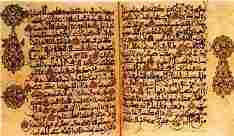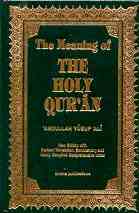The holy book of Islam, the Koran as a book is the result of:
- revelations given to Muhammad in the period 610- 632 (until Muhammad's death)
- writing down of these revelations by people around Muhammad in a period probably starting some years after 610, and ending a couple of years after 632
- compiling of these writings stretching from mid-630's and perhaps until mid-650's
- vowelling and dotting of the text (ancient Arabic was written without dots, leaving some letters look identical, and without vowels, which can make two different words look identical).
 Essential to the reading of the Koran are the interpretations, which are still conducted, but which were more normal and accepted in the first centuries of Islam. As the Koran has a structure and a language, as well as allusions, which often are difficult for the normal Muslim to understand, a whole science were built around the comprehension of the Koran. The early Muslims studied history, language and nature science in an effort of understanding the Koran better. The product is surprisingly well accepted by the whole Muslim society, and no Muslim child or adult of today, studying the Koran, does this without help from the interpretations built on the early science of the Koran.
Essential to the reading of the Koran are the interpretations, which are still conducted, but which were more normal and accepted in the first centuries of Islam. As the Koran has a structure and a language, as well as allusions, which often are difficult for the normal Muslim to understand, a whole science were built around the comprehension of the Koran. The early Muslims studied history, language and nature science in an effort of understanding the Koran better. The product is surprisingly well accepted by the whole Muslim society, and no Muslim child or adult of today, studying the Koran, does this without help from the interpretations built on the early science of the Koran.
The early efforts of Koranic science have given room for different approaches to the book and its content, but apart from the interpretations of the, all interpretations are looked upon as parallel, meaning that one can not be put ahead of the other. There are today 7 ways of reading the Koran, each of these have two variances, leaving the Muslims with 14 ways of reading the Koran. But in modern Koranic science this applies only to Muslim scholars, the ordinary Muslim reads the Koran without dealing with this complexity.
The Koran is divided into 114 suras, which are opened by indications on their origin. The origin is either Mecca or Medina. But it is generally accepted that some of suras have parts from the other city than the one they have as their origin. The whole structure of the Koran is a science in itself, as there is no chronology in it, like the one found in the Bible, and as the most of it consists of commandments and warnings, and only a part is stories.
The following can be said about its structure. Except the first sura, "Al-Fatiha", 'The Commencement', the longest suras are found in the beginning, and then gradually decreases on to the end of the Koran. Sura 2 "Al-Baqara", 'The Cow' is 286 ayat (verse) long, while sura 114 is 6 ayat long. But the shortest are sura 103, 106 and 108, all consisting of 3 ayat.
The main important issues of the Koran for the believer are:
- Being the focal point of all Muslims. The Koran is regarded by most as the uncreated word of God, written on golden tablets in Paradise. This view, strongly contended inside the Muslim world in the first centuries, marks the end of the most fruitful period of Muslim science. Until the middle of the 9th century AD (2nd Hijra century according to the Islamic calendar) the dominating view among theologians was that the Koran was created by God, hence his spoken words. For the Muslims today, the Koran is a physical proof of Islam.
- Being the sound of Islam. When recited, a holy atmosphere is created, an atmosphere involving God, the world, the truth and peace. During the moment of reciting, the compound becomes sacred, and the moment powerful. The reciting of the Koran is an art known by most Muslims. The technique used normally involves sitting on the ground with the book in the lap or placed on specially made low table. This sitting position is resembling the lotus position used in eastern religions, but is not at all strict on the upright position of the spine, most Muslims bend over the Koran they read. The reading technique uses a rhythm with around 60 beats a second. The performance of this rhythm, is done with both torso, swaying a little in a oval shape, and voice and reading speed. Surprisingly overlooked by most western scholars, the reading of the Koran is a meditative moment for all Muslims, and a ritual that can be performed anywhere anytime, not only in the mosque.
- The Koran's actual guidance in everyday life for Muslims, must not be overestimated. Muslim's think of the Koran as too complex to be a guide in daily matters, as interpreted by a Muslim layman. When a Muslim have a problem where the Holy Koran is involved, asking learned men or reading books written by men learned in Islamic sciences, is the choice of most. There are situations where Muslims look up the Koran for guidance, but this will be in cases where they know what to look for, and where to look.
Translations of the Koran
 Muslims speaking Arabic will normally stick to an Arabic version of the Koran. They will read the Koran according to the way described above. If they don't speak Arabic then they will read a translation of Koran in their native language (such as Turkish in Turkey).
Muslims speaking Arabic will normally stick to an Arabic version of the Koran. They will read the Koran according to the way described above. If they don't speak Arabic then they will read a translation of Koran in their native language (such as Turkish in Turkey).
Translations of the Koran is in many cases a result of the need of western scholars and others in the west interested in Islam. The first translation of the Koran into another language was to Latin in 1143, and this was performed by a monk, in the need of understanding the Crusaders' enemy. From the 18th century and up until now, the Koran has been translated into most world languages, and with a steadily increasing quality. Today most Muslims endorse this effort, with the hope that some mis-understandings on Islam can be refuted, and also that Islam can reach more people around the world.

